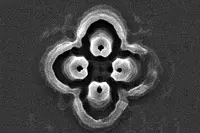Electronics News
Archive : 8 December 2014 год
 In a move aimed at developing new technologies that will support high speed networks in densely populated areas, the University of Southampton is to join the European and Japanese backed Safari project.
In a move aimed at developing new technologies that will support high speed networks in densely populated areas, the University of Southampton is to join the European and Japanese backed Safari project.
Safari is one of four research projects receiving €12million from the EU and Japan. In all, there will be more than 40 academic and industry partners.
Safari – short for Scalable And Flexible optical Architecture for Reconfigurable Infrastructure – is being funded with €1.5m from the Horizon 2020 programme. The work will bring together researchers from Southampton's Optoelectronics Research Centre (ORC), Coriant and the Technical University of Denmark, as well as NTT and Fujikura.
ORC deputy director Professor David Richardson said: "We are delighted to be engaged in the exciting and ambitious project which brings together leading European and Japanese research groups to address some of the key emerging challenges and opportunities facing our increasingly information-centric global society."
In particular, Safari will look to build high speed networks capable of supporting at least 400Gbit/s per channel. These will combine multicore optical fibres with space division multiplexing to produce scalable and flexible optical transport networks.
Author
Graham Pitcher
Source: www.newelectronics.co.uk
 A National College for Digital Skills will open in London in 2015, the government announced today.
A National College for Digital Skills will open in London in 2015, the government announced today.
The aim is to provide tomorrow's 'digital innovators' and coders with high level technical training, so that the UK can compete in the 'global race'.
"This is all part of our long term economic plan for Britain – making sure our children have the skills they need to thrive and get on," said Prime Minister David Cameron. "And by sticking to it, we will lift our children horizons and pull our country up in the world."
The college will start working with students in London next year before similar centres are established across the country.
Other parts of Cameron's plan include a £67million initiative, covering the next five years, which will give extra maths and science training for 15,000 existing teachers and an additional 2,500 teachers.
The extra training was announced as pupils visited Downing Street for a lesson in computer coding, as part of the international Hour of Code project.
"It will take time but it's absolutely vital for the success of our country that we teach maths and science and computing in the modern way, because that will be one of the things that will determine whether we succeed or not," said Cameron.
Speaking about the launch of the new National College for Digital Skills, Peter Finegold, head of education and skills at the Institution of Mechanical Engineers (IMechE), said: "It is encouraging that the government is prioritising science, maths and engineering. The Prime Minister is right to say that developing the right skills in the right sectors is crucial to creating a strong and balanced economy."
Finegold warned, however, that more work needs to be done to improve the poor standards of careers advice on offer to most students. He also called for better links between schools and local industries.
He continued: "Government also needs to seriously consider the possibility of providing subsidies for students pursuing degrees in business critical subjects like science and engineering and needs to put in place rigorous standards for apprentices to ensure they are in industries where there is a real potential for jobs, like engineering, and that standards are verified through accreditation by bodies such as the IMechE."
Author
Laura Hopperton
Source: www.newelectronics.co.uk
 Researchers from North Carolina State University have developed a lithography technique in which nanoscale spheres are placed on a photosensitive film in order to create 3D structures.
Researchers from North Carolina State University have developed a lithography technique in which nanoscale spheres are placed on a photosensitive film in order to create 3D structures.
Because the nanospheres polystyrene spheres are transparent, they bend and scatter light in predictable ways. The researchers can control the nanolithography by altering the size of the nanosphere, exposure duration and the angle, wavelength and polarisation of light. The approach can also use single or multiple light beams, allowing a range of nanostructure designs to be created.
"We are using the nanosphere to shape the pattern of light, which gives us the ability to shape the resulting nanostructure in three dimensions without using the expensive equipment required by conventional techniques," said Dr Chih-Hao Chang, an assistant professor of mechanical and aerospace engineering at NC State. "And it allows us to create 3D structures all at once, without having to make layer after layer of 2D patterns."
The team believes the technique could be used to create nanoscale 'inkjet printers' for creating electronic devices, antennas and photonic components.
Author
Graham Pitcher
Source: www.newelectronics.co.uk
